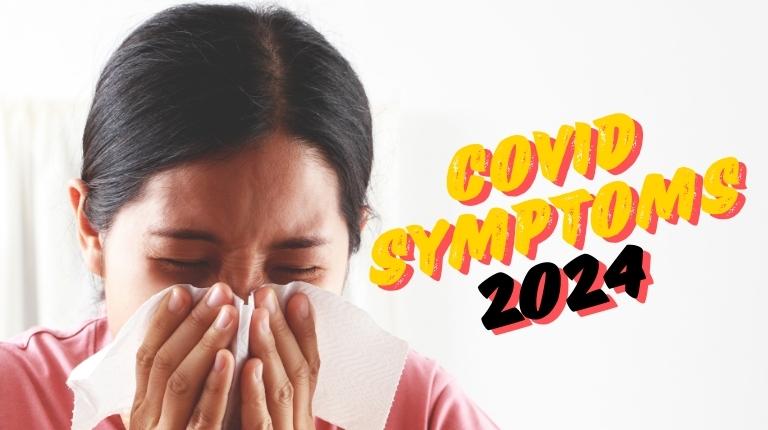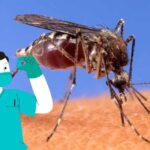COVID-19 Symptoms: In 2024, the world is still grappling with the effects of the COVID-19 pandemic. As the virus continues to evolve, new symptoms have emerged, adding to the already complex web of uncertainty. In this article, we dive into the mysteries surrounding these new symptoms 2024 and shed light on what to watch for.
Amidst the chaos, it’s essential to stay informed and vigilant. The latest research suggests that alongside the well-known symptoms of fever, cough, and shortness of breath, individuals infected with COVID-19 may now experience a range of unfamiliar manifestations. These symptoms can include fatigue, loss of taste and smell, skin rashes, delirium, and even new neurological complications.
Read More: Alliance Finds West Nile Virus at Maple Beach Park
Understanding these new symptoms is crucial for early detection and effective management of the virus. By providing you with up-to-date and accurate information, we aim to empower you to protect yourself and your loved ones against this ever-evolving threat.
As we unravel the mysteries of these new COVID-19 symptoms, join us as we navigate the uncharted territory of the pandemic and explore what lies ahead. Stay tuned for an informative and enlightening exploration of this alarming development.
Evolution of COVID-19 symptoms
The symptoms of COVID-19 have evolved since the virus was first identified. Initially, the most common symptoms included:
Read More
- Fever: A high temperature was often the first sign of infection.
- Cough: A persistent dry cough was reported frequently.
- Fatigue: Many patients experienced extreme tiredness.
- Loss of Taste and Smell: Anosmia became a distinctive symptom, although it wasn’t present in all cases.
As the pandemic progressed and variants emerged, the symptom profile began to change:
- Milder Symptoms: Many later variants, particularly Omicron, resulted in milder symptoms akin to a common cold. Symptoms included:
- Runny or stuffy nose
- Sore throat
- Headache
- Gastrointestinal Symptoms: Nausea, vomiting, and diarrhea were more commonly reported in some cases.
- Respiratory Symptoms: Shortness of breath remained a significant concern, especially in severe cases.
- Fatigue and Muscle Aches: Continued to be reported but with varying intensity.
- Long COVID: Some individuals experienced prolonged symptoms (known as Long COVID), which could include fatigue, brain fog, and joint pain lasting for weeks or months after the acute infection.
Common symptoms of COVID-19 in 2024
Common symptoms of COVID-19 include:
- Fever: A high temperature, often above 100.4°F (38°C).
- Cough: Typically a dry cough that persists.
- Fatigue: A feeling of extreme tiredness or lack of energy.
- Loss of Taste or Smell: Anosmia, or a sudden inability to taste or smell, is notable.
- Sore Throat: Discomfort or pain in the throat.
- Shortness of Breath: Difficulty breathing or a feeling of being winded.
- Congestion or Runny Nose: Nasal congestion or clear nasal discharge.
- Headache: Pain or discomfort in the head.
- Muscle or Joint Pain: General aches and pains.
- Gastrointestinal Symptoms: Nausea, vomiting, or diarrhea may occur.
Emerging symptoms of COVID-19 in 2024
As of 2024, emerging symptoms of COVID-19 continue to evolve, particularly with new variants. Some of the symptoms that have gained attention include:
- Cold-like Symptoms: Many recent infections present with symptoms similar to the common cold, such as:
- Runny or stuffy nose
- Sneezing
- Gastrointestinal Issues: Increased reports of nausea, vomiting, and diarrhea.
- Neurological Symptoms: Some patients report:
- Brain fog
- Confusion or difficulty concentrating
- Skin Rashes: Newer variants have been associated with skin symptoms, such as rashes or hives.
- Fatigue and Weakness: Ongoing fatigue remains common, especially in cases of Long COVID.
- Eye Symptoms: Conjunctivitis (pink eye) has been reported in some cases.
- Chest Discomfort: Some individuals experience tightness or discomfort in the chest without respiratory distress.
Read More: FDA Approves Blood Test to Screen for Colon Cancer
Why new symptoms are appearing
New symptoms of COVID-19 are emerging due to several factors:
- Variants of the Virus: The virus that causes COVID-19 continues to mutate, leading to new variants. These variants may have different properties that affect how the virus interacts with the human body, potentially resulting in a wider range of symptoms.
- Immune Response: As the population builds immunity through vaccinations and prior infections, the immune response can influence symptom expression. Individuals with some level of immunity might experience milder symptoms or a different symptom profile compared to those who are unvaccinated.
- Viral Load: The amount of virus an individual is exposed to (viral load) can affect the severity and type of symptoms. Higher viral loads may lead to more severe or atypical symptoms.
- Changes in Host Factors: Individual factors such as age, underlying health conditions, and overall health can influence how symptoms present. As the virus spreads through different populations, variations in these factors can lead to changes in symptom profiles.
- Long COVID: Some individuals who recover from acute COVID-19 may experience ongoing symptoms (Long COVID), leading to the identification of new symptoms that weren’t as commonly reported during the initial phases of the pandemic.
- Increased Awareness and Reporting: As more is learned about the virus, healthcare providers and patients are more aware of atypical symptoms, leading to increased reporting and recognition.
Recognizing and diagnosing new COVID-19 symptoms
Recognizing and diagnosing new COVID-19 symptoms in 2024 involves a combination of awareness, testing, and clinical evaluation. Here are some key points:
1. Awareness of Symptoms
- Stay informed about the evolving list of COVID-19 symptoms, including traditional ones (fever, cough, loss of taste/smell) and emerging symptoms (cold-like symptoms, gastrointestinal issues, neurological symptoms, skin rashes).
- Be attentive to any combination of symptoms, as COVID-19 can present differently in individuals.
2. Testing
- PCR and Rapid Antigen Tests: If you experience symptoms consistent with COVID-19, get tested. PCR tests are highly accurate, while rapid antigen tests provide quicker results.
- Home Testing: Home test kits are widely available and can help you quickly determine if you may be infected.
3. Clinical Evaluation
- Consult a healthcare provider if you have symptoms. They may conduct a physical examination and take a detailed history of your symptoms and any potential exposure to the virus.
- Be prepared to provide information on:
- Recent travel or exposure to known COVID-19 cases
- Vaccination history
- Any pre-existing health conditions
4. Differential Diagnosis
- Healthcare providers may consider other illnesses (e.g., influenza, common cold, allergies) when diagnosing. They may order additional tests if needed to rule out other conditions.
5. Follow-up and Monitoring
- If diagnosed with COVID-19, monitor your symptoms and seek medical attention if they worsen (e.g., difficulty breathing, chest pain).
- Long COVID symptoms should be reported and assessed by a healthcare provider for appropriate management.
6. Reporting and Public Health Guidance
- Report positive test results to local health authorities as they may provide further guidance and support.
- Follow public health recommendations regarding isolation and notifying close contacts.
Potential impact of new symptoms on public health
The emergence of new COVID-19 symptoms can have significant implications for public health, including:
1. Diagnostic Challenges
- Misdiagnosis: New or atypical symptoms may lead to confusion, resulting in misdiagnosis or delayed diagnosis of COVID-19.
- Increased Testing Demand: Variability in symptoms may drive more people to seek testing, potentially overwhelming healthcare systems.
2. Public Awareness and Behavior
- Changes in Public Perception: Awareness of new symptoms can alter how individuals perceive their risk and may encourage more cautious behavior, such as increased testing and vaccination.
- Stigma and Anxiety: Uncertainty about symptoms may lead to increased anxiety about illness and potential stigma associated with seeking testing.
3. Impact on Healthcare Resources
- Increased Healthcare Utilization: A broader range of symptoms may lead to more individuals seeking care, straining healthcare resources and emergency services.
- Long COVID Management: The recognition of new symptoms related to Long COVID could require additional resources for ongoing care and support.
4. Surveillance and Reporting
- Enhanced Surveillance Needs: Public health agencies may need to enhance surveillance systems to monitor and track new symptoms, ensuring timely data collection and analysis.
- Adaptation of Public Health Guidelines: Guidelines for isolation, quarantine, and treatment may need to be updated based on new symptom profiles.
5. Vaccination and Treatment Strategies
- Targeted Public Health Campaigns: Campaigns may need to emphasize recognition of new symptoms to ensure timely diagnosis and treatment.
- Vaccine Efficacy Studies: Research may be necessary to assess how well existing vaccines protect against variants associated with new symptoms.
6. Community Response and Policy Adjustments
- Adjustments in Policies: Public health policies may need to be revised based on the changing landscape of symptoms, including school and workplace guidelines.
- Increased Focus on Mental Health: Ongoing uncertainty and fear surrounding COVID-19 may require additional mental health support services.
Read More: 4 Habits That Are Ruining Your Brain Health
Preventive measures to reduce the risk of COVID-19
Preventive measures to reduce the risk of COVID-19 include a combination of personal practices and community-wide strategies:
1. Vaccination
- Get Vaccinated: Stay up to date with COVID-19 vaccinations and boosters as recommended by health authorities to enhance protection against severe illness.
2. Personal Hygiene
- Hand Hygiene: Wash hands frequently with soap and water for at least 20 seconds, especially after being in public places. Use hand sanitizer with at least 60% alcohol if soap and water are not available.
- Avoid Touching Face: Refrain from touching your eyes, nose, and mouth with unwashed hands.
3. Mask Wearing
- Wear Masks: Use masks in crowded or indoor settings, especially where ventilation is poor or transmission rates are high. Choose high-quality masks (e.g., N95, KN95) for better protection.
4. Physical Distancing
- Maintain Distance: Keep at least 6 feet (2 meters) of distance from others in crowded places, particularly in indoor settings.
5. Avoid Crowded Places
- Limit Gatherings: Avoid large gatherings, especially in enclosed spaces. Opt for outdoor activities when possible.
6. Ventilation
- Improve Indoor Ventilation: Ensure good ventilation in indoor spaces by opening windows and doors or using air filtration systems.
7. Stay Informed
- Monitor Local Health Guidelines: Stay updated on local COVID-19 transmission rates and health recommendations, and adapt behaviors accordingly.
8. Self-Testing and Quarantine
- Self-Testing: Use rapid antigen tests or PCR tests if you experience symptoms or have been in close contact with someone who tested positive.
- Isolate if Sick: If you feel unwell or test positive for COVID-19, stay at home and follow public health guidelines regarding isolation.
9. Travel Precautions
- Follow Travel Guidelines: Adhere to travel advisories and guidelines, including testing and quarantine requirements, especially when traveling to areas with high transmission.
10. Promote Health Education
- Educate Others: Share accurate information about COVID-19 prevention and the importance of following health guidelines within your community.
Research and studies on new COVID-19 symptoms in 2024
Research on new COVID-19 symptoms continues to evolve as scientists and healthcare professionals study the virus and its variants. Here are some key areas of focus:
1. Variant-Specific Symptoms
- Studies have investigated how symptoms vary between different variants of the virus, such as Delta and Omicron. Research indicates that Omicron infections often present with milder symptoms, resembling those of a common cold, such as runny nose and sore throat, while Delta was associated with more severe respiratory symptoms.
2. Long COVID
- Ongoing research explores the long-term effects of COVID-19, known as Long COVID. Studies have identified a range of persistent symptoms, including fatigue, brain fog, and joint pain, affecting individuals even months after recovery from the acute phase of the illness.
3. Gastrointestinal Symptoms
- Emerging studies highlight gastrointestinal symptoms like nausea, vomiting, and diarrhea as more common in some COVID-19 cases, particularly with certain variants. Research is examining the mechanisms behind these symptoms and their implications for diagnosis and treatment.
4. Neurological Symptoms
- Research has increasingly focused on neurological manifestations of COVID-19, such as headaches, dizziness, and cognitive dysfunction. Studies are investigating how the virus affects the central nervous system and contributes to conditions like brain fog.
5. Skin Manifestations
- Dermatological studies have reported new skin symptoms, including rashes and hives, associated with COVID-19. Research aims to clarify the characteristics of these symptoms and their prevalence among different populations.
6. Surveillance and Monitoring
- Public health agencies have implemented enhanced surveillance systems to monitor changes in symptom profiles. This includes analyzing data from healthcare providers and testing results to identify patterns and trends related to new symptoms.
7. Patient Surveys and Reports
- Patient-reported outcomes surveys have been conducted to gather firsthand accounts of symptoms experienced during and after COVID-19. This qualitative data helps researchers understand the full impact of the virus on health and well-being.
8. Clinical Trials
- Ongoing clinical trials are exploring treatments for both acute COVID-19 symptoms and Long COVID, providing insights into the most effective management strategies for emerging symptoms.
Conclusion and future considerations
In conclusion, remaining aware of the new COVID-19 symptoms to watch for in 2024 is essential for both individual well-being and community health. Together, we can continue to unravel the mysteries of COVID-19 and adapt our responses to protect ourselves and our loved ones.



